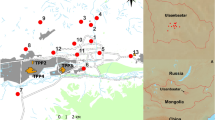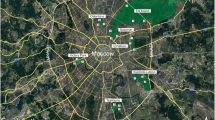Abstract
In urban environments, human exposure to air pollutants is expected to be significantly increased, especially near busy traffic streets, street canyons, tunnels, etc. where urban topography and microclimate may additionally cause poor air conditions giving rise to pollution hotspots. As a practical and cost-effective approach, active moss biomonitoring survey of some major and trace element air pollution was performed in the Belgrade street canyons and city tunnel in 2011 with the aim to evaluate possibility of using Sphagnum girgensohnii moss bags for investigation of the small-scale vertical and horizontal distribution patterns of the elements. In five street canyons, the moss bags were hung at heights of about 4, 8 and 16 m, during 10 weeks, and also, for the same time, the moss bags were exposed in the tunnel, in front of and out of it. After the exposure period, the concentrations of Al, Ba, Ca, Cd, Co, Cr, Cu, Fe, K, Mg, Mn, Na, Ni, Pb, Sr, V and Zn in the moss were determined by inductively coupled plasma optical emission spectrometry. According to the results, in all street canyons, the vertical distribution patterns of the moss elements concentration (Al, Ba, Co, Cr, Cu, Ni, Pb, Sr, V and Zn) showed statistically significant decrease from the first to the third heights of bags exposure. In the tunnel experiment, from inner to out of the tunnel, for Al, Ba, Cd, Co, Cr, Cu, Fe, K and Zn, decreasing trend of concentrations was obtained. Significantly higher concentration of the elements was pronounced for the tunnel in comparison with the street canyons. The results indicate that the use of S. girgensohnii moss bags is a simple, sensitive and inexpensive way to monitor the small-scale inner city spatial distribution of airborne major and trace element content.





Similar content being viewed by others
References
Adamo P, Giordano S, Vingiani S, Castaldo CR, Violante P (2003) Trace element accumulation by moss and lichen exposed in bags in the city of Naples (Italy). Environ Pollut 122:91–103
Adamo P, Crisafulli P, Giordano S, Minganti V, Modenesi P, Monaci F, Pittao E, Tretiach M, Bargagli R (2007) Lichen and moss bags as monitoring devices in urban areas. Part II: trace element content in living and dead biomonitors and comparison with synthetic materials. Environ Pollut 146:392–399
Al-Radady AS, Davies BE, French MJ (1993) A new design of moss bag to monitor metal deposition both indoors and outdoors. Sci Total Environ 133:275–283
Aničić M, Tasić M, Frontasyeva MV, Tomašević M, Rajšić S, Mijić Z, Popović A (2009a) Active moss biomonitoring of trace elements with Sphagnum girgensohnii moss bags in relation to atmospheric bulk deposition in Belgrade, Serbia. Environ Pollut 157:673–679
Aničić M, Tasić M, Frontasyeva MV, Tomašević M, Rajšić S, Strelkova LP, Popović A, Steinnes E (2009b) Active biomonitoring with wet and dry moss: a case study in an urban area. Environ Chem Lett 7:55–60
Aničić M, Tomašević M, Tasić M, Rajšić S, Popović A, Frontasyeva MV, Lierhagen S, Steinnes E (2009c) Monitoring of trace element atmospheric deposition using dry and wet moss bags: accumulation capacity versus exposure time. J Hazard Mater 171:182–188
Brown DH, Bates JW (1990) Bryophytes and nutrient cycling. J Linn Soc Bot 104:129–147
Carballeira A, Fernández JA, Aboal JR, Real C, Couto JA (2006) Moss: a powerful tool for dioxin monitoring. Atmos Environ 40:5776–5786
Colvile RN, Hutchinson EJ, Mindell JS, Warren RF (2001) The transport sector as a source of air pollution. Atmos Environ 35:1537–1565
Culicov OA, Mocanu R, Frontasyeva MV, Yurukova L, Steinnes E (2005) Active moss biomonitoring applied to en industrial site in Romania: relative accumulation of 36 elements in moss-bags. Environ Monit Assess 108:229–240
De Paul FT, Sheih CM (1986) Measurement of wind velocities in a street canyon. Atmos Environ 20(3):455–459
Fenger J (1999) Urban air quality—their physical and chemical characteristics. Atmos Environ 33:4877–4900
Fernández JA, Rey A, Carballeira A (2000) An extended study of heavy metal deposition in Galicia (NW Spain) based on moss analysis. Sci Total Environ 254:31–44
Fernández JA, Aboal JR, Carballeira A (2004) Identification of pollution sources by means of moss bags. Ecotoxicol Environ Saf 59:76–83
Giordano S, Adamo P, Sorbo S, Vingiani S (2005) Atmospheric trace metal pollution in the Naples urban area based on results from moss and lichen bags. Environ Pollut 136:431–442
Gromke C, Ruck B (2007) Influence of trees on the dispersion of pollutants in an urban street canyon—experimental investigation of the flow and concentration field. Atmos Environ 41:3287–3302
Gu Z-L, Zhang Y-W, Cheng Y, Lee S-C (2011) Effect of uneven building layout on air flow and pollutant dispersion in non-uniform street canyons. Build Environ 46:2657–2665
Harrison RM, Yin J (2000) Particulate matter in the atmosphere: which particle properties are important for its effects on health? Sci Total Environ 249:85–101
Jeong SJ, Andrews MJ (2002) Application of the k-ε turbulence model to the high Reynolds number skimming flow field of an urban street canyon. Atmos Environ 36:1137–1145
Lin CC, Chen SJ, Huang KL, Hwang-Guo WI, Chang-Chien GP, Lin WY (2005) Characteristics of metals in nano/ultrafine/fine/coarse particles collected beside a heavily trafficked road. Environ Sci Technol 21:8113–8122
Little P, Martin M (1974) Biological monitoring of heavy metal pollution. Environ Pollution 6:1–19
Ma C-J, Tohno S, Kasahara M (2004) A case study of the single and size-resolved particles in roadway tunnel in Seoul. Korea Atmos Environ 38:6673–6677
Markert BS, Breure AM, Zechmeister HG (2003) Definitions, strategies and principles for bioindications/biomonitoring of the environment. In: Markert BA, Breure AM, Zechmeister HG (eds) Bioindicators/biomonitors. Elsevier, Amsterdam, pp 3–41
Nicholson SE (1975) A pollution model for street-level air. Atmos Environ 9:19–31
Ntziachristos L, Ning Z, Geller DM, Sheesley JR, Schauer JJ, Sioutas C (2007) Fine, ultrafine and nanoparticle trace element composition near a major freeway with a high heavy-duty diesel fraction. Atmos Environ 41:5684–5696
Pavageau M, Rafailidis S, Schatzmann M (1996) A comprehensive experimental databank for the verification of urban car emission dispersion models. Fourth Workshop on Harmonisation within Atmospheric Dispersion Modelling for Regulatory Purposes, Ostende. vol. 2, pp. 443–450
Seaton A, Mac Nee W, Donaldson K, Godden D (1995) Particulate air pollution and acute health effects. Lancet 345:176–178
SEPA—Serbian Environmental Protection Agency (2011) http://www.sepa.gov.rs/ams/xajax_data/eas_kvalitet_vazduha_1.php
Singh M, Jaques AP, Sioutas C (2002) Size distribution and diurnal characteristic of particle-bound metals in source and receptor sites of the Los Angeles Basin. Atmos Environ 36:1675–1689
Sternbeck J, Sjödin Å, Andréasson K (2002) Metal emissions from road traffic and the influence of resuspension—results from two tunnel studies. Atmos Environ 36:4735–4744
Tretiach M, Pittao E, Crisafulli P, Adamo P (2011) Influence of exposure sites on trace element enrichment in moss-bags and characterisation of particles deposited on the biomonitor surface. Sci Total Environ 409:822–830
Vardoulakis S, Fisher BEA, Pericleous K, Gonzalez-Flesca N (2003) Modeling air quality in street canyons: a review. Atmos Environ 37:155–182
UNECE ICP Vegetation Report (2008) http://icpvegetation.ceh.ac.uk/publications/documents/AnnualReport2007_8Finalversionwithcorrectionstoproof.pdf
Viana M, Kuhlbusch TAJ, Querol X, Alastuey A, Harrison RM, Hopke PK, Winiwarter W, Vallius M, Szidat S, Prévôt ASH, Hueglin C, Bloemen H, Wåhlin P, Vecchi R, Miranda AI, Kasper-Giebl A, Maenhaut W, Hitzenberger R (2008) Source apportionment of particulate matter in Europe: a review of methods and results. Aerosol Sci 39:827–849
Wang P, Zhao D, Wang W, Mu H, Cai, Liao C (2011) Thermal effect on pollutant dispersion in an urban street canyon. Int J Environ Res 5(3):813–820
Weber S, Kuttler W, Weber K (2006) Flow characteristics and particle mass and number concentration variability within a busy urban street canyon. Atmos Environ 40:7565–7578
WHO (2005) Air quality guidelines for particulate matter, ozone, nitrogen dioxide and sulphur dioxide, global update. WHO, Geneva
Xie X, Huang Z, Wang JS, Xie Z (2005) The impact of solar radiation and street layout on pollutant dispersion in street canyon. Build Environ 40:201–212
Zechmeister HG, Grodzinska K, Szarek-Lukaszewska G (2003) Bioindicators/biomonitors (principles, assessment, concepts). In: Markert BA, Breure AM, Zechmeister HG (eds) Bryophytes. Elsevier, Amsterdam, pp 329–374
Zechmeister HG, Hohenwallner D, Riss A, Hanus-Illnar A (2005) Estimation of element deposition derived from road traffic sources by using mosses. Environ Pollut 138:238–249
Zechmeister HG, Hagendorfer H, Hohenwallner D, Hanus-Illnar A, Riss A (2006) Analyses of platinum group elements in mosses as indicators of road traffic emissions in Austria. Atmos Environ 40:7720–7732
Acknowledgments
This study was realised as a part of the project No III43007 financed by the Ministry of Education and Science of the Republic of Serbia within the framework of integrated and interdisciplinary research for the period 2011–2014, as well as in the frame of bilateral cooperation with Joint Institute for Nuclear Research, Dubna, Russia. The work is accomplished with the great help and understanding of City Assembly of Belgrade, City Secretariat for Environmental Protection, City Secretariat for Transport and Commercial Court of Belgrade.
Author information
Authors and Affiliations
Corresponding author
Additional information
Responsible editor: Elena Maestri
Rights and permissions
About this article
Cite this article
Vuković, G., Aničić Urošević, M., Razumenić, I. et al. Active moss biomonitoring of small-scale spatial distribution of airborne major and trace elements in the Belgrade urban area. Environ Sci Pollut Res 20, 5461–5470 (2013). https://doi.org/10.1007/s11356-013-1561-9
Received:
Accepted:
Published:
Issue Date:
DOI: https://doi.org/10.1007/s11356-013-1561-9




